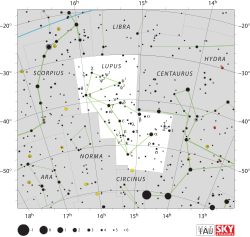Zeta Lupi
| Zeta Lupi (ζ) | |
 | |
| Observationsdata Epok: J2000 | |
|---|---|
| Stjärnbild | Vargen |
| Rektascension | 15t 12m 17,09595s[1] |
| Deklination | -52° 05′ 57,2919″[1] |
| Skenbar magnitud () | 3,41[2] (3,50 + 6,74)[3] |
| Stjärntyp | |
| Spektraltyp | G7 III[4] |
| U–B | +0,66[2] |
| B–V | +0,92[2] |
| Astrometri | |
| Radialhastighet () | -10,0 ± 0,6[5] km/s |
| Egenrörelse (µ) | RA: -112,92[1] mas/år Dek.: -71,18[1] mas/år |
| Parallax () | 27,80 ± 0,15[1] |
| Avstånd | 117,3 ± 0,6 lå (36,0 ± 0,2 pc) |
| Absolut magnitud () | 0,65[6] |
| Detaljer | |
| Massa | 2,29[6] M☉ |
| Radie | 10[7] R☉ |
| Luminositet | 53[8] L☉ |
| Temperatur | 5 335[8] K |
| Metallicitet | 0,00 ± 0,02[9] |
| Andra beteckningar | |
| ζ Lup, CD-51° 8830, FK5 558, GJ 9512 A, HD 134505, HIP 74395, HR 5649, SAO 242304, WDS J15123-5206A. [10] | |
Zeta Lupi (ζ Lupi, förkortad Zeta Lup, ζ Lup), som är stjärnans Bayer-beteckning, är en dubbelstjärna i södra delen av stjärnbilden Vargen. Den har en kombinerad magnitud av 3,41[2] och är väl synlig för blotta ögat där ljusföroreningar ej förekommer. Baserat på parallaxmätning inom Hipparcosuppdraget på ca 27,8 mas,[1] beräknas den befinna sig på ett avstånd av ca 117 ljusår (36 parsek) från solen.
Egenskaper
Primärstjärnan Zeta Lupi A är en gul till vit jättestjärna av spektralklass G7 III[4] och befinner sig i röda klumpen, vilket anger att den genererar energi genom fusion av helium i dess kärnområde.[11] Den har en massa som är 2,3[6] gånger solens massa, en radie som är ca 10[7] gånger solens radie och avger ca 53[8] gånger mer energi än solen från dess fotosfär vid en effektiv temperatur på ca 5 300 K.[8]
Zeta Lupi är en sannolik dubbelstjärna,[12] och år 2013 hade stjärnparet en vinkelseparation på 71,20 bågsekunder vid en positionsvinkel på 68,8°. Följeslagaren Zeta Lupi B har en skenbar magnitud på 6,74.[3]
Referenser
- Den här artikeln är helt eller delvis baserad på material från engelskspråkiga Wikipedia, 23 januari 2019.
Noter
- ^ [a b c d e f] van Leeuwen, F (November 2007). "Hipparcos, the New Reduction". Astronomy and Astrophysics. VizieR; Centre de Données astronomiques de Strasbourg. 474 (2): 653–664. arXiv:0708.1752. Bibcode:2007A&A...474..653V. doi:10.1051/0004-6361:20078357.
- ^ [a b c d] Johnson, H. L.; et al. (1966), "UBVRIJKL photometry of the bright stars", Communications of the Lunar and Planetary Laboratory, 4 (99), Bibcode:1966CoLPL...4...99J.
- ^ [a b] Mason, B. D.; et al. (2014), "The Washington Visual Double Star Catalog", The Astronomical Journal, 122: 3466–3471, Bibcode:2001AJ....122.3466M, doi:10.1086/323920, retrieved 2015-07-22.
- ^ [a b] Gray, R. O.; et al. (July 2006), "Contributions to the Nearby Stars (NStars) Project: spectroscopy of stars earlier than M0 within 40 pc-The Southern Sample", The Astronomical Journal, 132 (1): 161–170, arXiv:astro-ph/0603770, Bibcode:2006AJ....132..161G, doi:10.1086/504637.
- ^ de Bruijne, J. H. J.; Eilers, A.-C. (October 2012), "Radial velocities for the HIPPARCOS-Gaia Hundred-Thousand-Proper-Motion project", Astronomy & Astrophysics, 546: 14, arXiv:1208.3048, Bibcode:2012A&A...546A..61D, doi:10.1051/0004-6361/201219219, A61.
- ^ [a b c] Pizzolato, N.; et al. (September 2000), "Evolution of X-ray activity of 1-3 Msun late-type stars in early post-main-sequence phases", Astronomy and Astrophysics, 361: 614–628, Bibcode:2000A&A...361..614P.
- ^ [a b] Lang, Kenneth R. (2006), Astrophysical formulae, Astronomy and astrophysics library, 1 (3rd ed.), Birkhäuser, ISBN 3-540-29692-1. The radius (R*) is given by::
- ^ [a b c d] McDonald, I.; et al. (2012), "Fundamental Parameters and Infrared Excesses of Hipparcos Stars", Monthly Notices of the Royal Astronomical Society, 427 (1): 343–57, arXiv:1208.2037, Bibcode:2012MNRAS.427..343M, doi:10.1111/j.1365-2966.2012.21873.x.
- ^ Soubiran, Caroline; et al. (June 2016), "The PASTEL catalogue: 2016 version", Astronomy & Astrophysics, 591: 7, arXiv:1605.07384, Bibcode:2016A&A...591A.118S, doi:10.1051/0004-6361/201628497, A118.
- ^ "zet Lup". SIMBAD. Centre de données astronomiques de Strasbourg. Hämtad 2017-03-03.
- ^ Laney, C. D.; et al. (2012). "A new Large Magellanic Cloud K-band distance from precision measurements of nearby red clump stars". Monthly Notices of the Royal Astronomical Society. 419 (2): 1637. arXiv:1109.4800. Bibcode:2012MNRAS.419.1637L. doi:10.1111/j.1365-2966.2011.19826.x.
- ^ Eggleton, P. P.; Tokovinin, A. A. (September 2008), "A catalogue of multiplicity among bright stellar systems", Monthly Notices of the Royal Astronomical Society, 389 (2): 869–879, arXiv:0806.2878, Bibcode:2008MNRAS.389..869E, doi:10.1111/j.1365-2966.2008.13596.x.
Externa länkar
- https://www.universeguide.com/star/zetalupi
- http://stars.astro.illinois.edu/sow/zetalup.html
| |||||||||||||||||||















